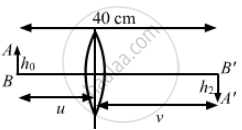Advertisements
Advertisements
प्रश्न
A pin of length 2.00 cm is placed perpendicular to the principal axis of a converging lens. An inverted image of size 1.00 cm is formed at a distance of 40.0 cm from the pin. Find the focal length of the lens and its distance from the pin.
उत्तर
Given,
Height of the object, (h0) = 2 cm,
Height of the image, (h1) = 1 cm
distance between image and object, ( \[-\] u + v) = 40 cm 
We know that,
Magnification is given by:
\[m = \frac{h_i}{h_0} = \frac{v}{u}, \frac{1}{2} = \frac{v}{- u}\]
u = −2v
Using lens formula,
\[\frac{1}{v} - \frac{1}{u} = \frac{1}{f}\]
\[ \Rightarrow \frac{1}{v} - \frac{1}{- 2v} = \frac{1}{f}\]
\[ \Rightarrow \frac{1}{v} + \frac{1}{2v} = \frac{1}{f}\]
\[ \Rightarrow f = \frac{2v}{3}\]
As per the question,
= −u + v = 40 cm,
= −(−2v) + v = 40 cm,
= 3v = 40 cm
\[v = 13 . 3 = \frac{40}{3} cm, u = \frac{80}{3}\]
∴ f = 8.9 cm
Hence, the required focal length is 8.9 cm and object distance is 26.66 cm.
APPEARS IN
संबंधित प्रश्न
What is meant by a power of a lens? Define its SI unit.
A doctor has prescribed a corrective lens of power +1.5 D. Find the focal length of the lens. Is the prescribed lens diverging or converging?
Consider two statements A and B given below:
A: real image is always inverted
B: virtual image is always erect
Out of these two statements:
What is the power of a convex lens lens whose focal length is 80 cm?
What is the nature of a lens whose power is, −4 D?
How is the power of a lens related to its focal length?
How is the sign (+ or -) of power of a lens related to its divergent or convergent action?
How does focal length of a lens change when red light incident on it is replaced by violet light? Give reason for your answer.
A screen is placed a distance 40 cm away from an illuminated object. A converging lens is placed between the source and the screen and its is attempted to form the image of the source on the screen. If no position could be found, the focal length of the lens
A 5.0 diopter lens forms a virtual image which is 4 times the object placed perpendicularly on the principal axis of the lens. Find the distance of the object from the lens.
Consider the situation described in the previous problem. Where should a point source be placed on the principal axis so that the two images form at the same place?
How is accommodation produced?
Which lens has more power a thick lens or a thin lens?
The power of a lens is +2.0 D. Find its focal length and state the kind of lens.
If there is a convex lens of focal length 75 cm and a concave lens of focal length 40 cm, then calculate their combined power and combined focal length.
The power of the magnifying glass depends on the distance of the magnifying glass from object.

The above lens has a focal length of 10 cm. The object of height 2 mm is placed at a distance of 5 cm from the pole. Find the height of the image.
An object is kept at a distance of 1m from a lens of power +2D:
- Identify the type of lens.
- Calculate its focal length and distance of the image formed.
The focal length of a double convex lens is equal to the radius of curvature of either surface. What is the refractive index of its material?
